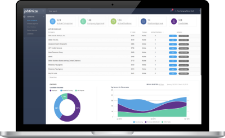State of Hiring 2022
By PXT Select
Download this white paper to keep on your files – DOWNLOAD
Mitigating Unconscious Bias during Hiring and Selection
In the increasingly complex and ambiguous world we live in, companies find themselves scrambling to find talent to fill open roles across all levels. There are challenges sourcing, hiring, and retaining top talent. This drastic shift in the labor market has sidetracked proactive efforts to create a diverse and equitable workforce resulting in reactive practices filling gaps with whatever is possible(1).
It is no surprise that most hiring managers and decision-makers with understaffed, burned-out, and overworked teams view structured hiring and selection processes as time-consuming.
They favor instinct or intuition for its quick approach, but this decision makes the hiring process susceptible to the effects of unconscious bias. Unconscious bias in hiring and selection can significantly impact an organization’s ability to hire diverse and qualified candidates as its automatic and elusive nature makes it hard to recognize and address.
The Impact of Unconscious Bias
Hiring managers and employees alike are susceptible to unconscious bias and may unknowingly make decisions and choices, both personally and organizationally, that can exclude certain individuals based on a single characteristic or trait.
Thus, unconscious bias could derail an organization’s ability to be diverse, equitable, and successful. The stressful experience of being understaffed can leave many organizations feeling dire, making speed the predominant criteria in the selection process. This leaves proactive efforts to hire for Diversity, Equity, and Inclusion (DE&I) placed lower on the ladder of considerations. But choosing this route not only increases an organization’s risk of unconscious bias but may also have a long-term effect on an organization’s ability to attract and retain quality talent.
In order to better understand the impact of unconscious bias on hiring and selection and its long-term impact in the workplace, Wiley Professional Learning surveyed over 5,000 working professionals. Survey respondents included individual contributors (43%) and managers or other leadership positions (57%). About half of all respondents had some involvement in the hiring process, with managers representing the largest portion of this group. In this report, we will share our findings and suggest the actions your organization can take to combat unconscious bias in hiring and selection.
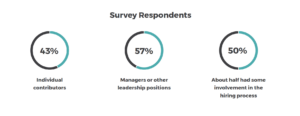
________________________________________
Unconscious Bias Defined
Unconscious bias is a concept that affects everyone, individuals, organizations, institutions, and too many systems to name. Although widely discussed, unconscious bias remains an abstract concept for many. In fact, while 77% of respondents reported having familiarity with the concept, only 12% rated themselves as being extremely familiar with unconscious bias.
The term unconscious bias was first introduced by Anthony Greenwald and Mahzarin Banaji(2) in 1995 to contest earlier beliefs that attitudes and stereotypes were developed consciously or deliberately. Instead, Greenwald and Banaji argued that past experiences had a residual effect on attitudes and stereotypes—meaning that past experiences, even those we forgot having, may still influence how we form attitudes, beliefs, and behaviors.
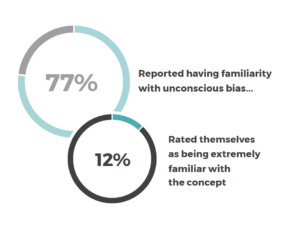
So, what does that mean? Take a moment to imagine a “successful Fortune 500 executive.” What words immediately come to mind? What specific physical attributes do they have?
More than likely, the terms “executive,” “successful,” or “Fortune 500” triggered images and memories from past firsthand experiences, news articles, movies, and tv shows that allow you to create a picture of this person. You probably envisioned a person of a specific age, race, or gender and may even be able to describe their personality or values.
These thoughts happen quickly and automatically. This process, where our brains try to expedite information processing by pulling references from past experiences and beliefs, can result in biased judgments. Unconscious bias is generally defined as the automatic associations people make between multiple characteristics and social categories, such as race, age, gender, or disability, and attitudes/beliefs, generated from prior experiences, that influence how we interact with people in those groups, especially in situations where quick decision-making is needed(2).

________________________________________
Unconscious Bias: A Human Condition
It’s important to understand that unconscious bias is a normal process. It’s neither inherently negative nor positive; instead, it is a way for our brains to synthesize the complexities of the world in easier-to-interpret patterns and associations. Every person has at some point initiated and/or experienced unconscious bias, even if they didn’t know it at that moment. In fact, 86% of survey respondents identified having either directly experienced or witnessed unconscious bias.
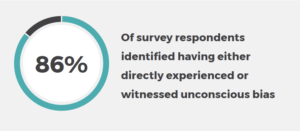
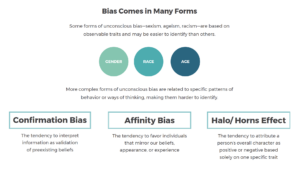
In our survey, most respondents identified multiple observable traits in their definition of unconscious bias, including race, gender, sex, and age. They also associated these traits with common bias outcomes, including prejudice, judgment, and stereotypes.
________________________________________

Unconscious Bias in the Workplace
Unconscious bias isn’t limited to an individual’s personal life; we bring it to work, too. Nearly 77% of our survey respondents “strongly agreed” that unconscious bias can occur in the workplace. Over 50% of respondents indicated that they have both personally experienced and witnessed coworkers experience unconscious bias in the workplace.
Unconscious bias not only impacts employee experiences, but it also affects the organizational processes created and used by employees.
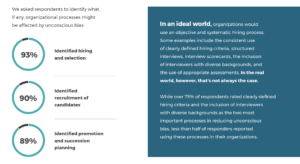
________________________________________
So, How Are Hiring and Selection Decisions Typically Made?
The reality is that most hiring managers still rely on instinct more than data when it comes to making hiring and selection decisions.
In 2020, Wiley fielded the first State of Hiring survey with over 3,000 hiring managers and found that 65% of participants were guiding their hiring decisions based on instinct rather than data(3). That 65% may unknowingly be influenced by their unconscious biases when making important decisions. As hiring managers develop a comprehensive understanding of their organization’s needs, they also may become adept at identifying potential pitfalls in candidates.
During their tenure, many hiring managers develop a strong sense of confidence in their ability to read people and fully trust their instinct in hiring and selection decisions. The high value hiring managers place on prioritizing experience and instinct in hiring and selection makes this process susceptible to unconscious bias, especially when checks and balances are not put in place.
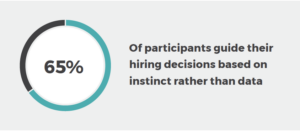
________________________________________
Instinct Is Fallible
For example, some hiring managers place a high value on where a candidate went to college and use this to determine who gets invited to interview. This natural affinity toward what’s familiar may feel like a safe choice, but it also limits the potential to find unique, diverse, and highly qualified candidates.
With organizations facing a struggle for talent and hiring managers feeling pressured to fill positions quickly, it is understandable that instinct is winning over process. But instinct is fallible. Therefore, it is critical for hiring managers to understand its role in introducing, sustaining, and exacerbating unconscious bias.
________________________________________

Combating Unconscious Bias in Hiring
Where there are people, unconscious bias exists. And unconscious bias in the workplace, especially in hiring, is inevitable. But here’s the good news, organizations that address unconscious bias are likely to gain access to qualified candidates, have a greater ability to retain existing employees, and have a diverse and equitable workplace environment.
________________________________________
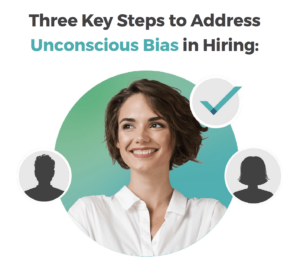
 Awareness Is key
Awareness Is key
In our analysis of respondent data, we came to an important conclusion: Awareness is key in mitigating the effects of unconscious bias. We found that respondents who reported more familiarity with unconscious bias were more likely to identify incidents of unconscious bias and reported more occurrences than respondents less familiar with unconscious bias.
Conversely, our data suggests that respondents who had no awareness of unconscious bias were the least likely to agree that both “unconscious bias can occur in the workplace” and “unconscious bias in the workplace can make it difficult for individuals to build relationships with their colleagues.”
These results highlight the important relationship between awareness of unconscious bias and the ability to identify and acknowledge its effects. People cannot fix a problem they do not know they have. To reduce the impact of unconscious bias in the workplace, organizations must offer employees opportunities to learn and reflect on this issue.
As organizations build strategies for awareness, we must remember that the ability to identify unconscious bias is not innate but requires ongoing education.
Awareness Training Is Just the Beginning
Like many things, unconscious bias is a complex topic, and its impact can’t be reduced with just one training. While a single training may help workers learn to identify unconscious bias, this increase in awareness may also lead to a range of feelings, including denial, helplessness, and anger. Using “one and done” training for this complex issue does not allow the time and space needed to reflect on these internal conflicts5.
Successful unconscious bias awareness-building must be viewed as an ongoing process with trainings developed to guide individuals through each stage of change. This includes first helping people learn what unconscious bias is, how to identify it, and understanding its impact on relationships.
Organizations must consider the far-reaching implications unconscious bias can have on the workplace and overall culture. Training is the first step, followed by small group discussions and workshops to guide people through self-reflection and strategies to manage and change their biases. These multiple experiences also provide opportunities to practice skills, gain valuable feedback, strengthen relationships, and track progress to help promote and maintain positive change.
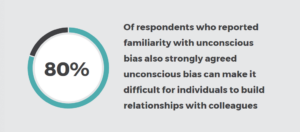
________________________________________

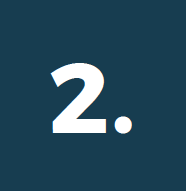 Assess Existing Organizational Structures
Assess Existing Organizational Structures
With a clear and shared understanding of unconscious bias, organizations will be better prepared to assess existing organizational structures and policies. As shown by the results of our survey, the hiring and selection process is highly prone to unconscious bias and can have a far-reaching impact on other processes. Therefore, it requires ample attention and a consistent approach to help minimize the impact of unconscious bias in the decision-making process.
Our survey indicated that 93% of respondents think hiring and selection can be impacted by unconscious bias. Specifically, respondents identified in-person/virtual interviews (62%) and application or resume screening (51%) as the top two areas where unconscious bias is most likely to occur.
For 85% of these respondents, the inclusion of specific factors, particularly the candidate’s name, photo, or pronouns, increased the likelihood of unconscious bias. When looking at how these respondents felt organizations should address unconscious bias in hiring, 85% felt that having some sort of structured process in hiring is important in addressing this risk of unconscious bias.
And although there is no magic formula for what a successful structured process looks like, as organizations needs evolve, so must the process. Successful organizations use data alongside managerial instinct.
![]()
Data Complements Instinct
Existing research has long advocated for the inclusion of structured data in hiring and selection decisions as it can improve a hiring manager’s ability to select the right candidate. In their study, Kuncel, Klieger, and Ones6 argued that while managers are skilled at both identifying the needs for a position and are great at evaluating candidates, they may not always be good at synthesizing the results.
Instead, they suggested an optimal hiring and decision process should use structured data to build a strong pool of candidates by which managers can make a final selection. Having multiple data points improved hiring and selection decisions by 25%. Nowicki and Rosse’s study found that managers, who were successful in hiring the best candidate for a role, attributed their success to a thorough hiring process in addition to luck and intuition. This included more thorough reference checking, interviewing, and determination of job requirements7.
In our survey, over 75% of respondents rated clearly defined hiring criteria, including interviewers with diverse backgrounds, skills assessment, and structured interviews as the top four structured hiring processes that could reduce unconscious bias.
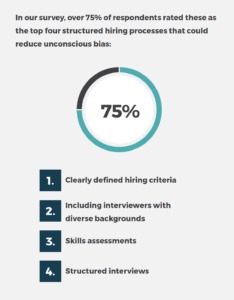
Unsurprisingly, respondents from organizations that used one or more of these structured processes were more likely to be confident in their organization’s hiring process, with respondents from organizations that used interviewers with diverse backgrounds having the highest confidence in their organization’s hiring process. Existing research and our current findings both paint a clear picture: The use of structured processes in hiring and selection can enhance a manager’s ability to not only select great candidates, but also reduce the impact of unconscious bias.
To start building a consistent structure for your organization, you should first determine clear steps in your process. They might include using Applicant Tracking Systems (ATS), personality assessments, assessing hard skills, and defined interview criteria. It could certainly be more or a combination of different data points. Then, you want to allocate weight to each step of the process to quantify the various data points. Finally, you should have more than one interviewer to assess each data point. The goal is to use data to complement the human perspective.
![]()
________________________________________

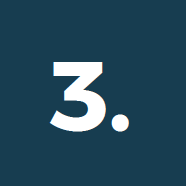 Commit to Diversity and Inclusion Initiatives
Commit to Diversity and Inclusion Initiatives
Another key strategy to reduce unconscious bias in the workplace is to develop and prioritize DE&I practices. In the United States, Title VII of the Civil Rights Act of 1964, specifically the Equal Employment Opportunity, states that organizations cannot discriminate against potential job applicants on race, religion, gender, ethnicity, nationality, and sexual orientation8,9.
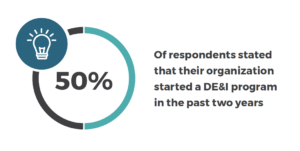
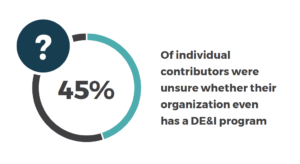
But it’s not just required by law, diversity within organizations is considered integral to organizational success. It increases creativity, innovation, loyalty, teamwork, and productivity. It also reduces the likelihood of unconscious bias and ensures that underrepresented groups have equal access to jobs they are qualified for10. Despite this, only 50% of our respondents stated that their organization started a DE&I program in the past two years. Even more surprising, 45% of individual contributors were unsure whether their organization even has one. Whether this is a result of the current job market and momentary de-prioritization of DE&I initiatives or just a lack of awareness, it is a significant barrier to the facilitation of change.

Diversity Means Organizational Success
The benefits of diversity are apparent; in our survey, 94% of respondents agreed that diversity benefits the workplace in some way. Respondents whose organizations have DE&I practices had more confidence in their organization’s hiring process to consistently hire the right person for each role.
Additionally, these respondents had more confidence in their own ability to identify unconscious bias and rated themselves as more likely to act if they were to witness a colleague experience unconscious bias. It’s crucial for employees to be aware of their own levels of unconscious bias so they can acknowledge the benefits of diversity in their organization.
Specifically, we found that respondents with a greater awareness of unconscious bias were twice as likely to acknowledge the benefits of diversity and significantly more likely to agree that diversity increases innovation and boosts creativity.
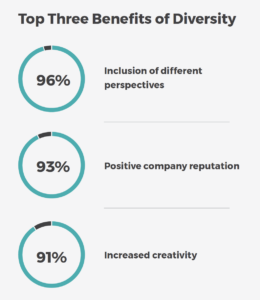
________________________________________

It’s a Cycle
When we asked respondents what the most important process was in increasing organizational diversity, the majority listed hiring and selection of candidates. Interestingly, these same respondents also listed hiring and selection as the process that presented the greatest challenge to increasing organizational diversity. While the exact cause for this paradox is unknown, the susceptibility of hiring and selection toward unconscious bias may be at its root.
The cyclical relationship between unconscious bias and diversity reminds us that organizations that struggle with unconscious bias are less likely to be diverse and will also struggle to achieve organizational success. Conversely, diverse organizations are more likely to reduce unconscious bias and achieve organizational success. For organizations struggling with understaffing and mass hiring, putting time-consuming DE&I practices on the backburner may seem like a logical choice, but as indicated in our survey, a lack of DE&I initiatives increases the risk of unconscious bias and limits an organization’s access to qualified candidates, increasing the likelihood of poor hiring and selection decisions. The decrease in candidate pool and increase in instinct-based hires perpetuate this cycle.
________________________________________
Conclusion
With the social and political unrest seen around the world recently, we’ve all witnessed the impact of biased actions. However, we often forget about our more immediate community and how we can start by making a difference in our own environment. We spend a large portion of our time at work, whether virtual, hybrid, or in person; it’s the perfect place to strive for a more equitable and safer environment.
As discussed in this paper, respondents reported the importance of recognizing, understanding, and acting on unconscious bias to strengthen hiring practices within their organizations. If companies want to remain relevant for candidates and continue to build towards their diversity and inclusion efforts, they need to make sure they are working with a structured and consistent hiring approach; it is imperative to supplement intuition with facts and data. Using people data, companies can foster awareness and create high-performing workforces.
________________________________________

Reduce Hiring Bias with PXT Select™
PXT Select™ assessments empower your organization to hire confidently with validated and actionable assessment data. Learn about your candidates at a deeper level, discover the power of job fit, and consider multiple factors that will impact their success on the job. Comprehensive and holistic, the assessment measures the three areas that impact an individual’s approach to situations in the workplace:



With over 30 years of experience, scientific research, and innovative technology, PXT Select assessments give organizations a competitive advantage by helping them align their talent needs, interview better, hire smarter, and ultimately retain longer. With the right people working in the right roles—your organization and people will thrive.
To discover how to use data to reduce hiring bias, connect with our team of experts.
To learn more, connect with your PXT Select Authorized Partner.
________________________________________
Study Notes and References
i. https://hbr.org/2021/09/the-great-resignation-doesnt-have-to-threaten-your-dei-efforts
ii. Greenwald, A. G., & Banaji, M. R. (1995). Implicit social cognition: attitudes, selfesteem, and stereotypes. Psychological review, 102(1), 4.
iii. https://www.pxtselect.com/LandingPages/state-of-hiring.aspx
iv. https://www.forbes.com/sites/forbeshumanresourcescouncil/2020/11/13/how-toleverage-skills-tests-to-reduce-unconscious-bias-in-hiring/?sh=7b74339b5d6f
v. https://hbr.org/2021/09/unconscious-bias-training-that-works
vi. Kuncel, N. R., Klieger, D. M., & Ones, D. S. (2014). In hiring, algorithms beat instinct. Harvard business review, 92(5), p32-32.
vii. Nowicki, M. D., & Rosse, J. G. (2002). Managers’ views of how to hire: Building bridges between science and practice. Journal of Business and Psychology, 17(2), 157-170.
viii. Miles, A., & Sadler-Smith, E. (2014). “With recruitment I always feel I need to listen to my gut”: The role of intuition in employee selection. Personnel Review.
ix. Title VII of the Civil Rights Act of 1964 | U.S. Equal Employment Opportunity Commission (eeoc.gov)
x. Uhlmann, E. L., & Cohen, G. L. (2007). “I think it, therefore it’s true”: Effects of self-perceived objectivity on hiring discrimination. Organizational Behavior and Human Decision Processes, 104(2), 207-223.
xi. https://www.managementstudyguide.com/organizational-diversity.htm
xii. Allen, B. J., & Garg, K. (2016). Diversity matters in academic radiology: acknowledging and addressing unconscious bias. Journal of the American College of Radiology, 13(12), 1426-1432.
xiii. Onyeador, I. N., Hudson, S. K. T., & Lewis Jr, N. A. (2021). Moving beyond implicit bias training: Policy insights for increasing organizational diversity. Policy Insights from the Behavioral and Brain Sciences, 8(1), 19-26.
________________________________________
Industries Represented by Survey Respondents
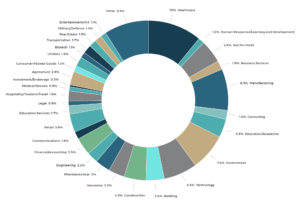

 Find a Solution
Find a Solution 